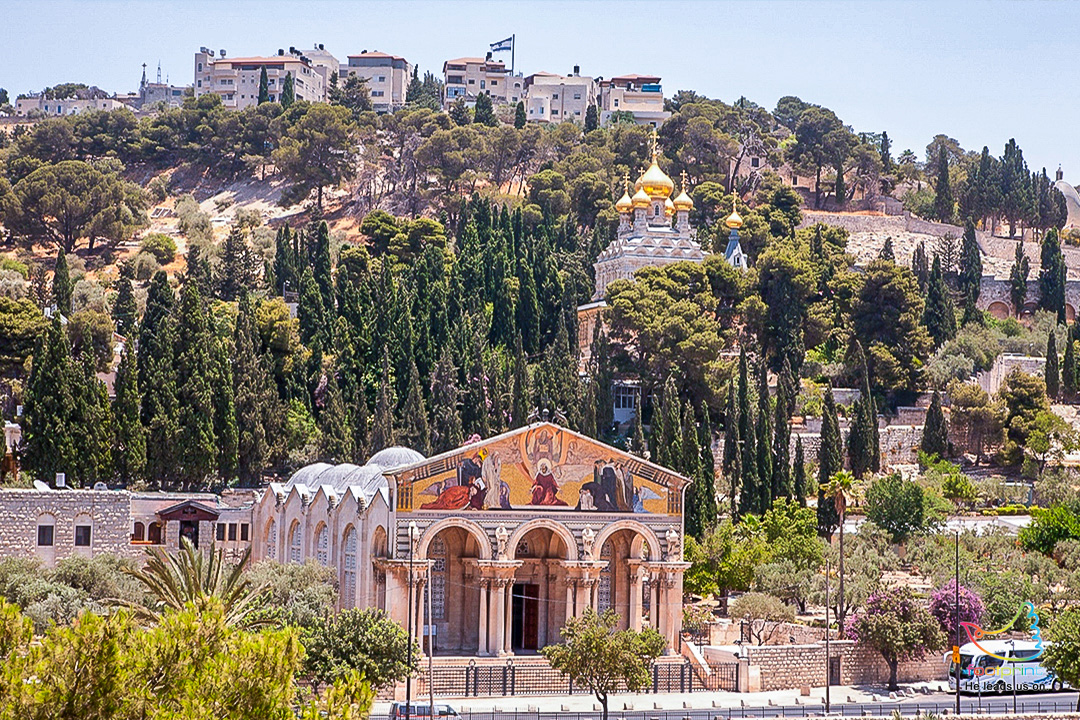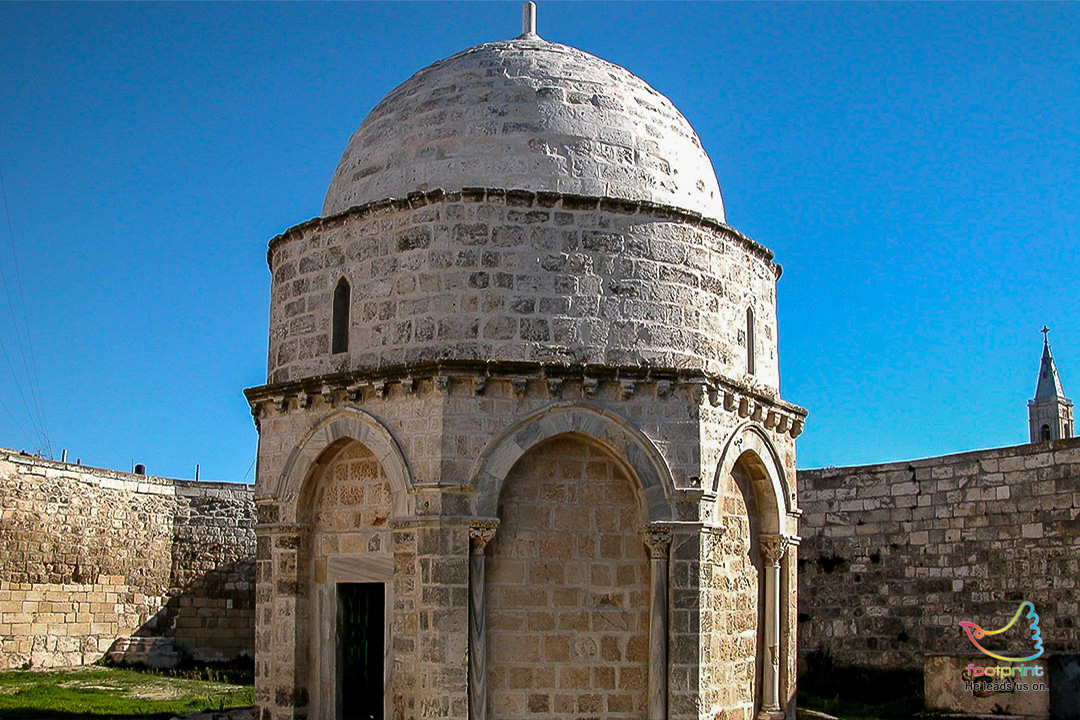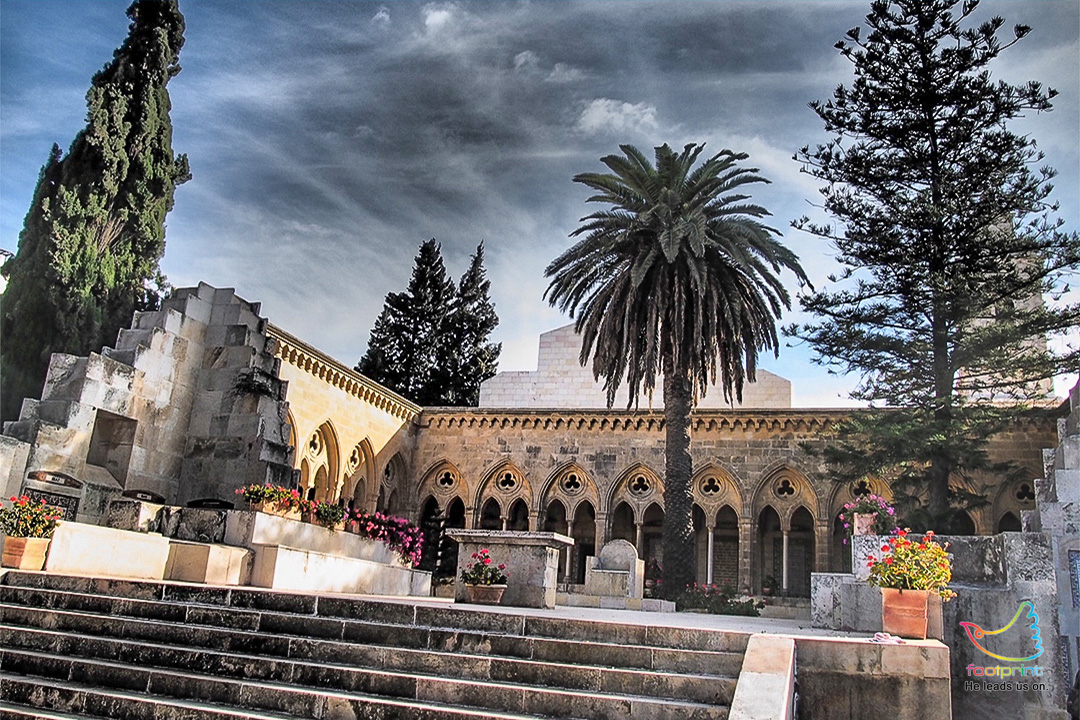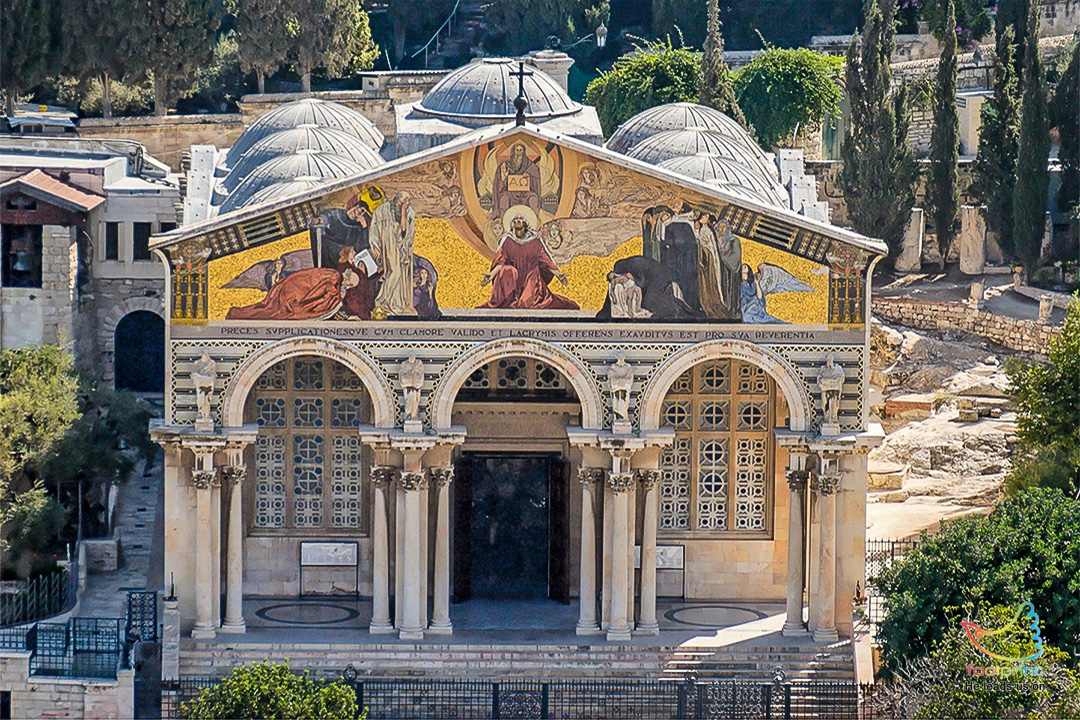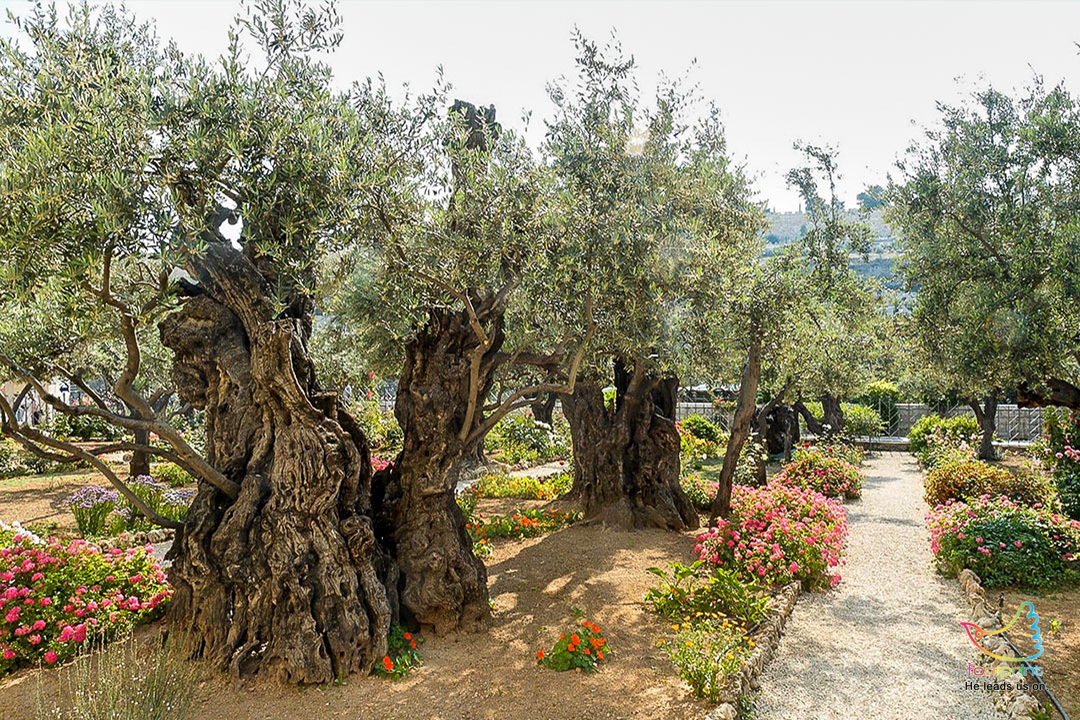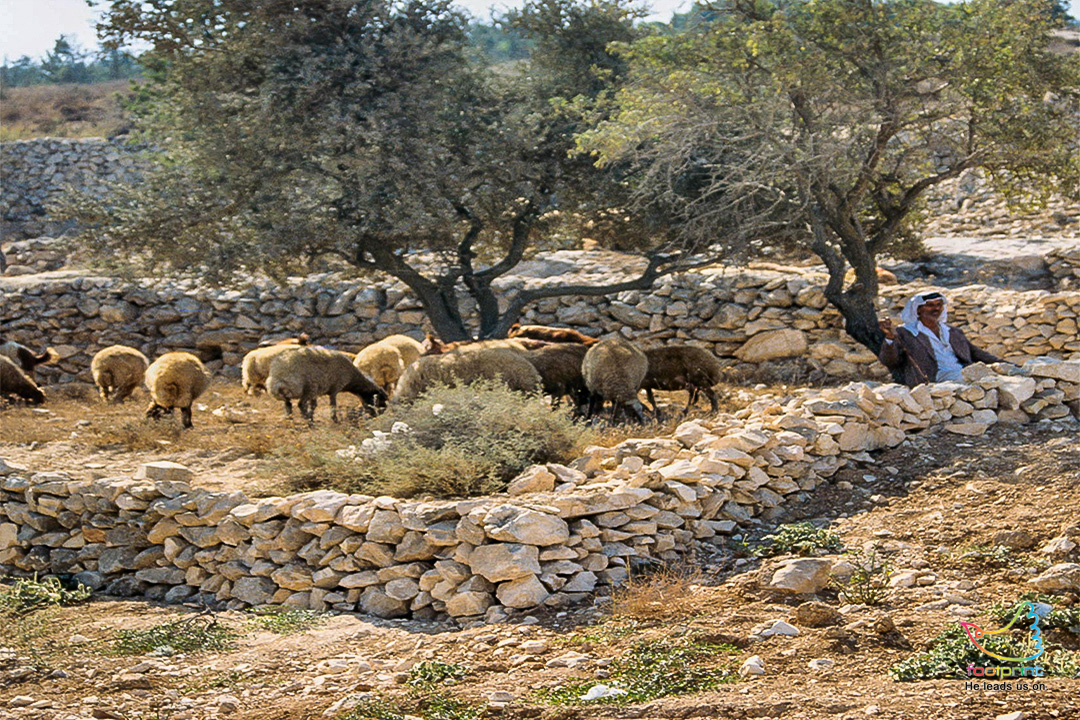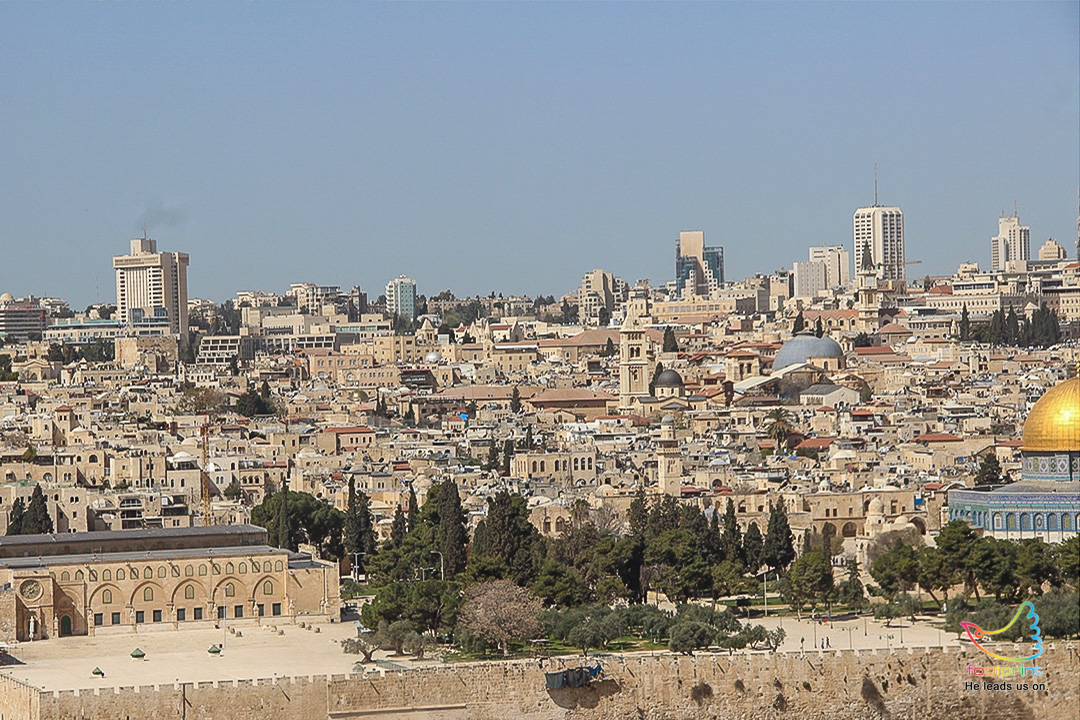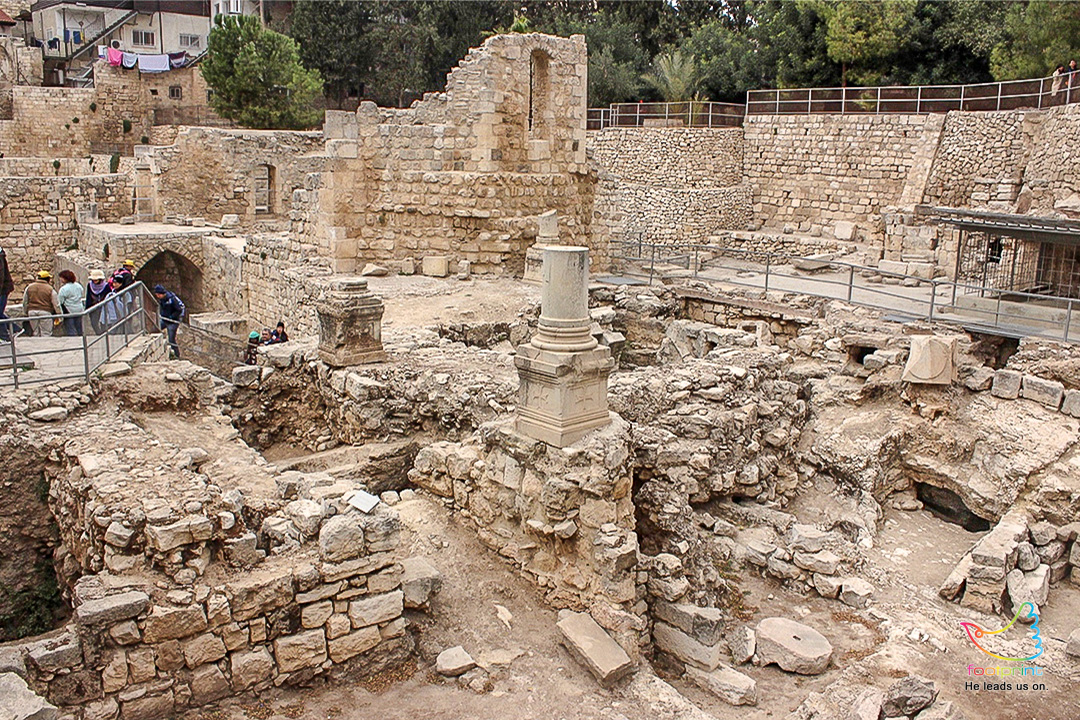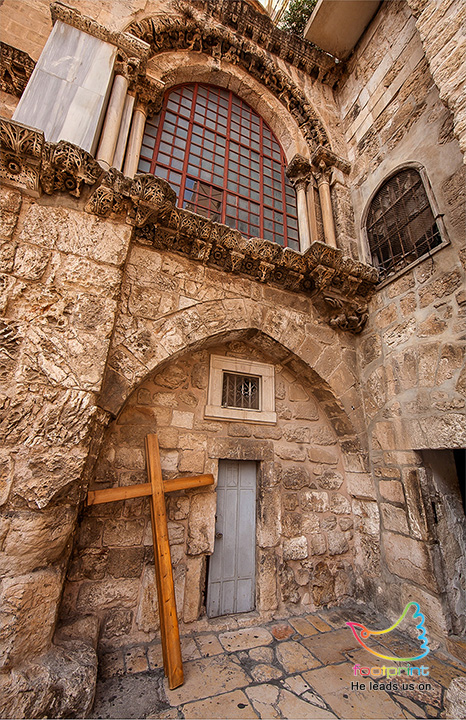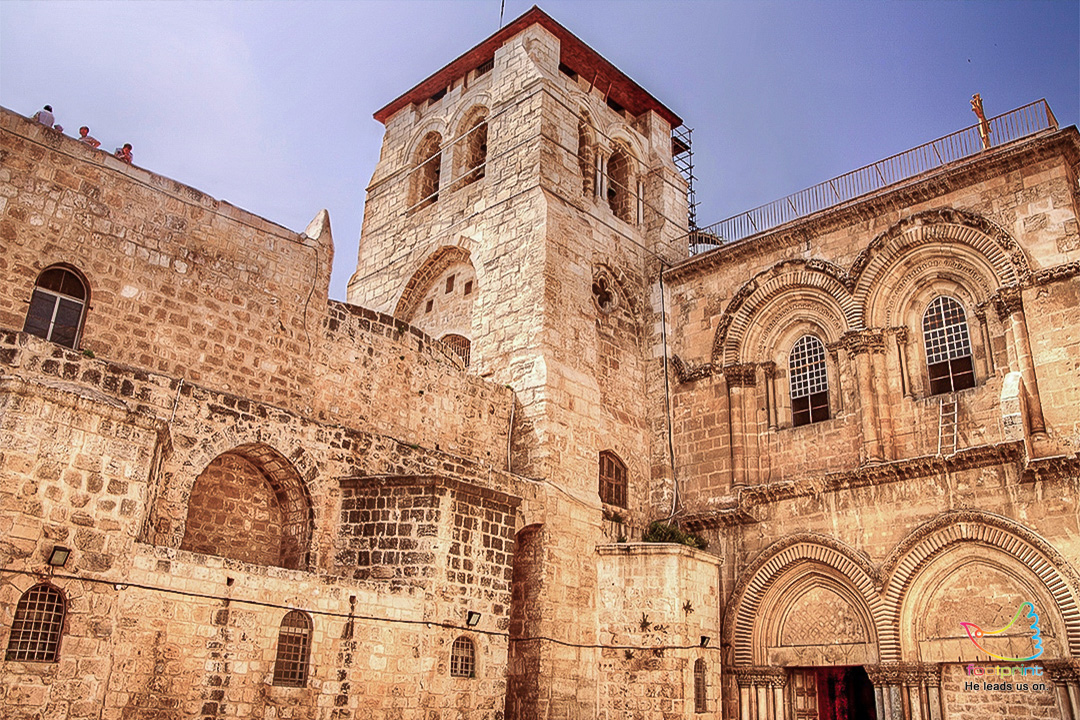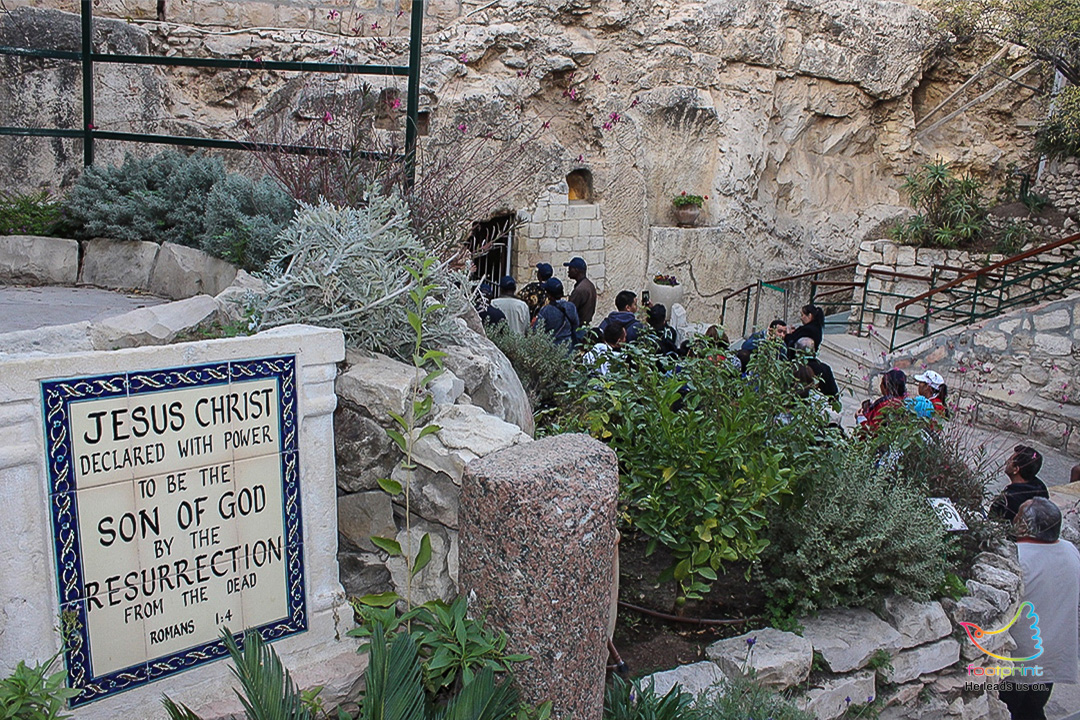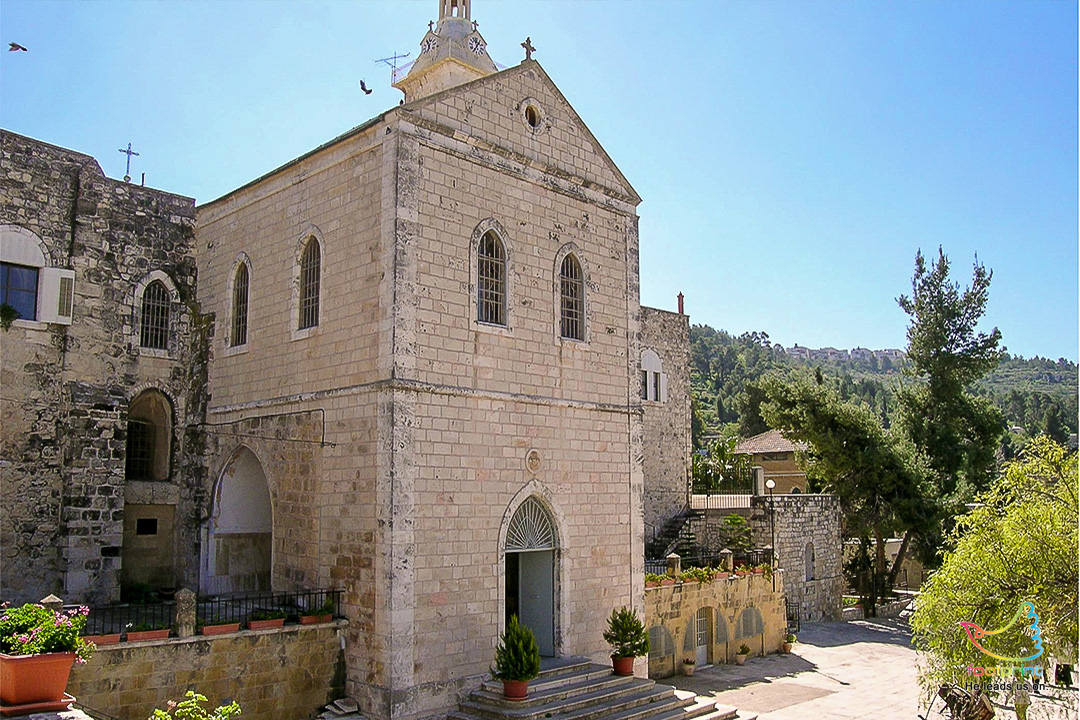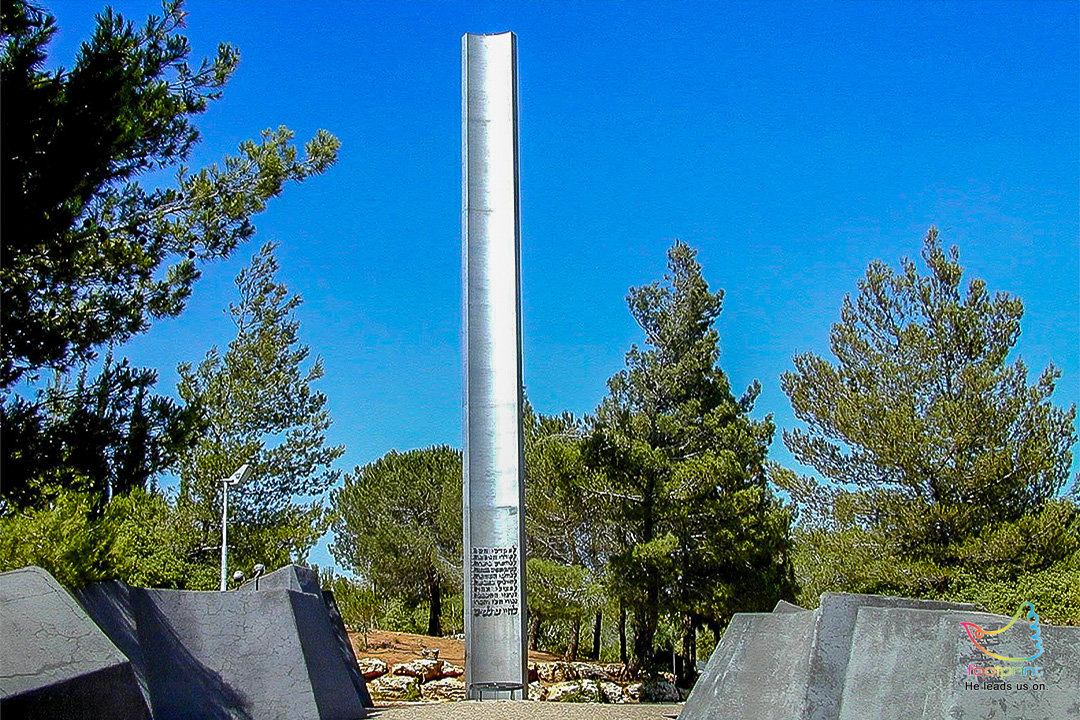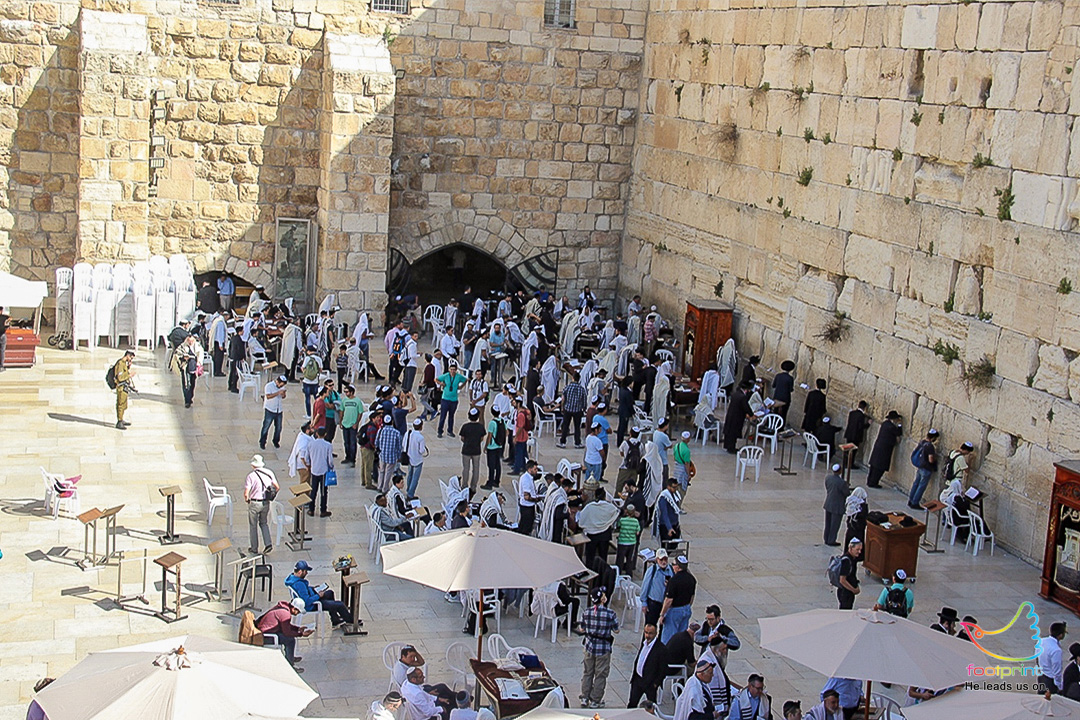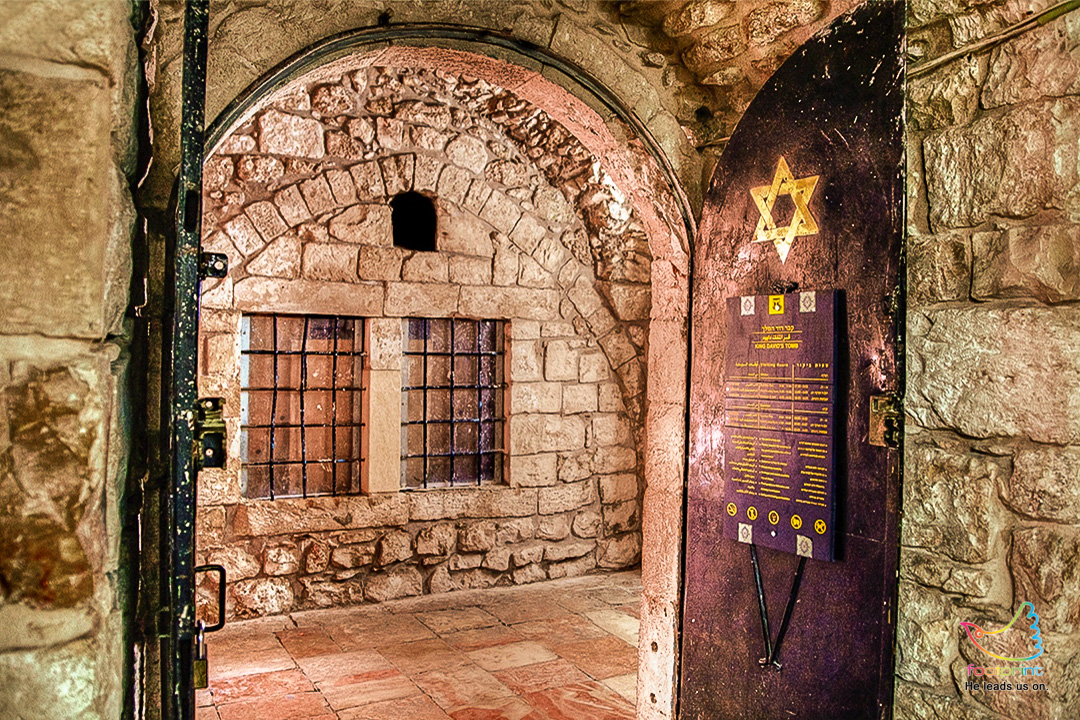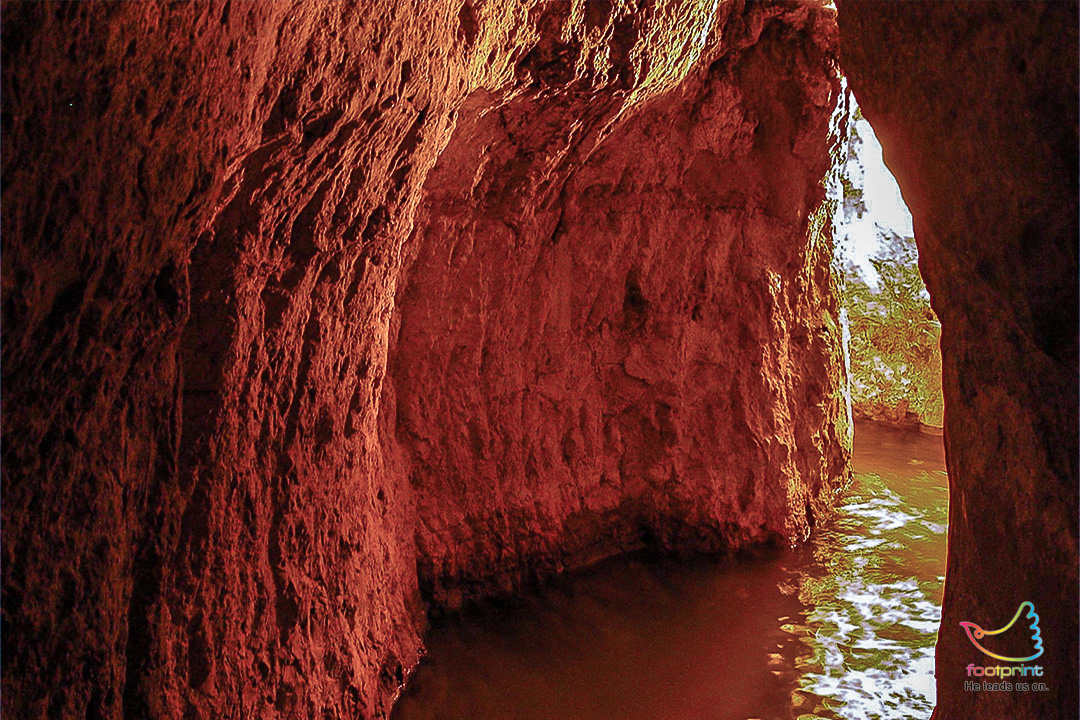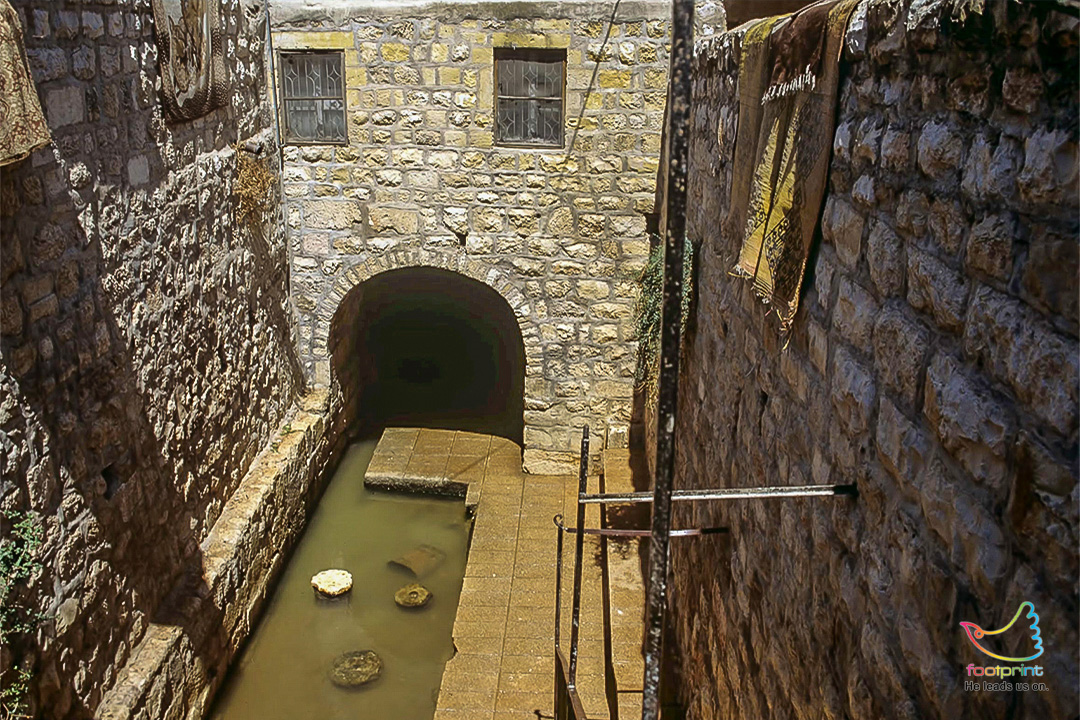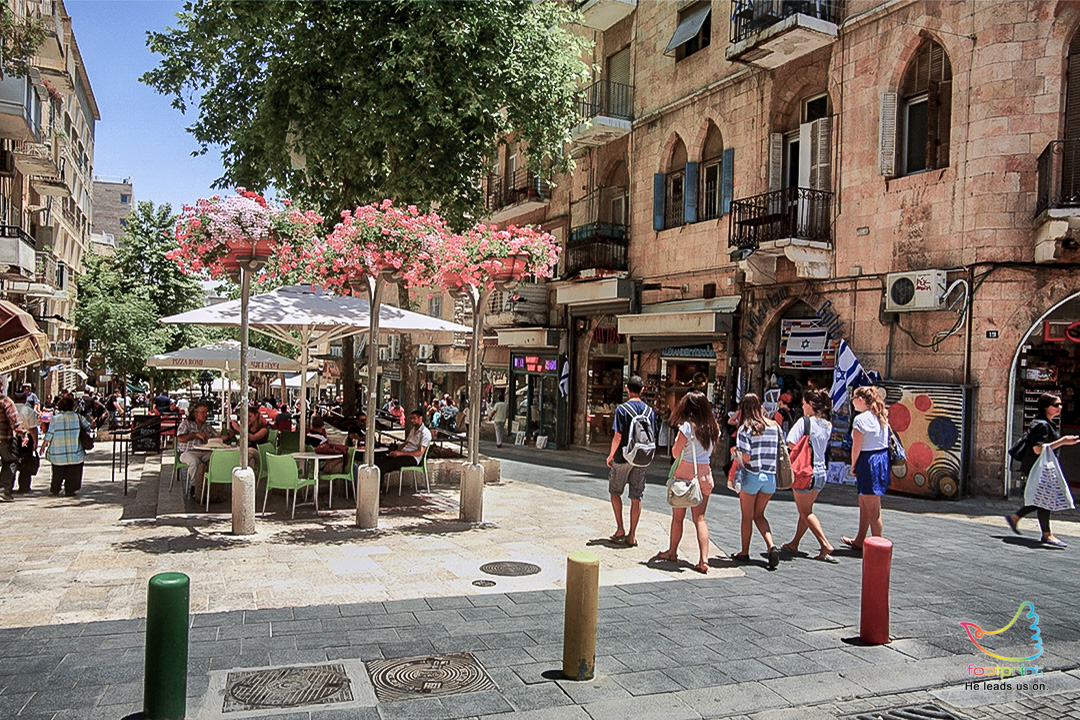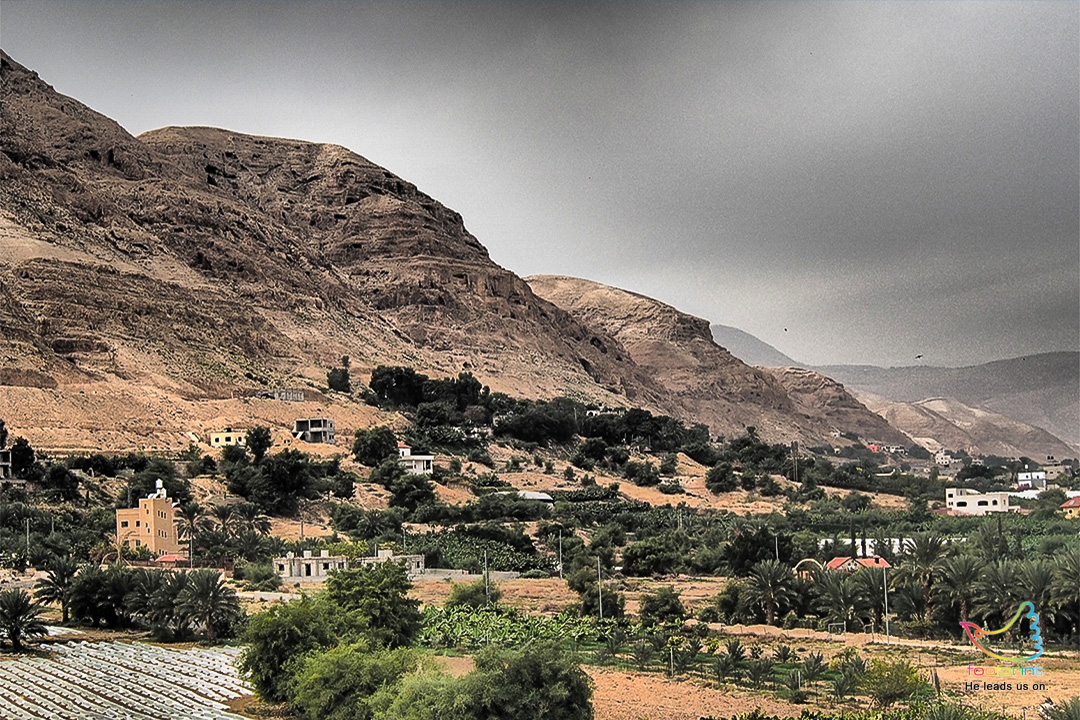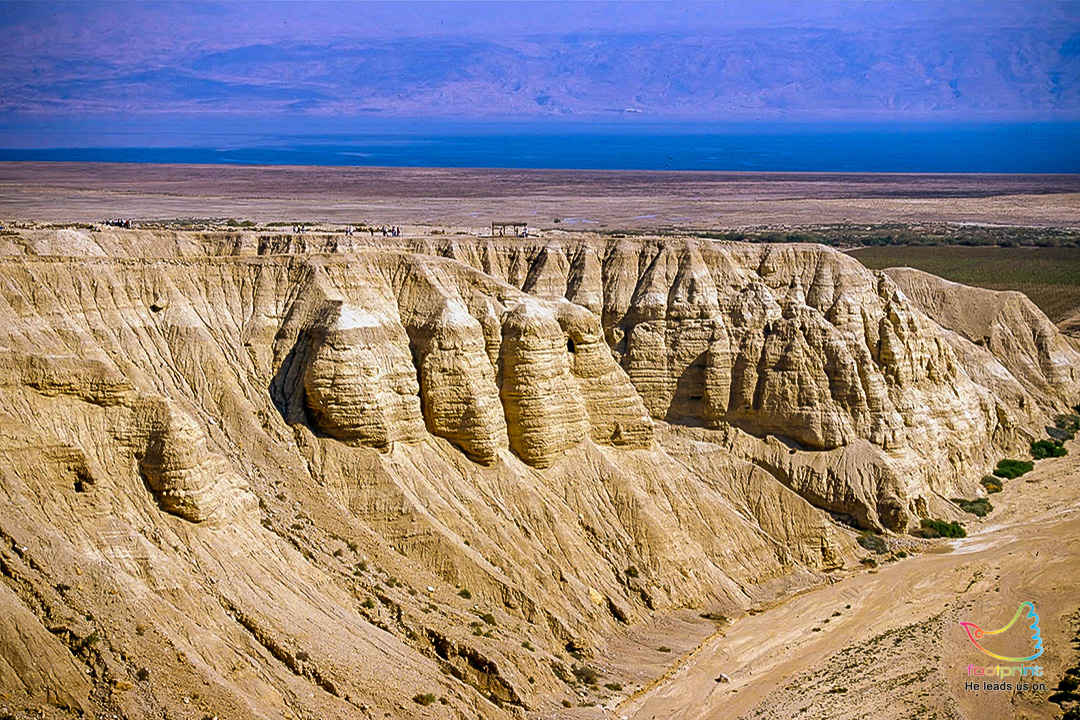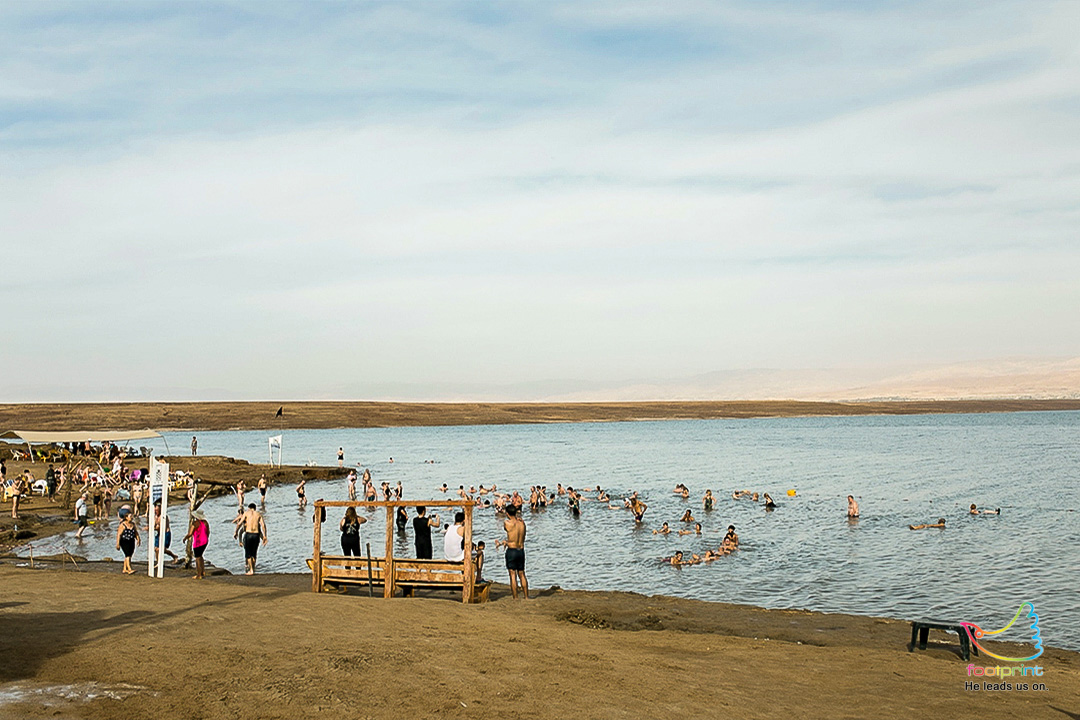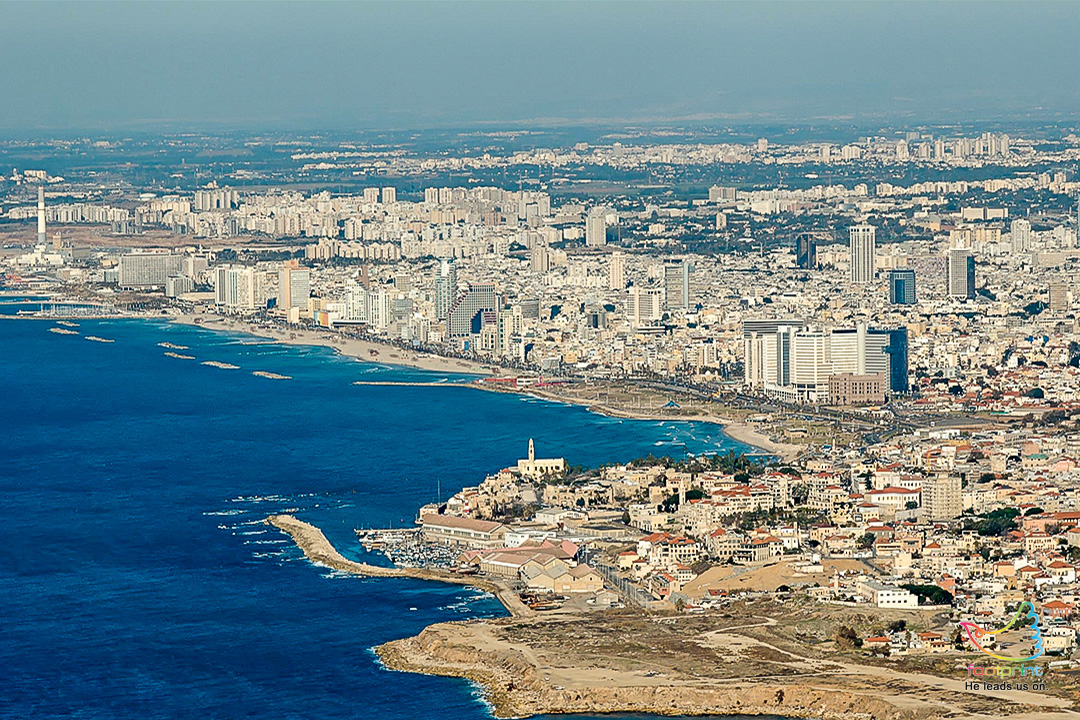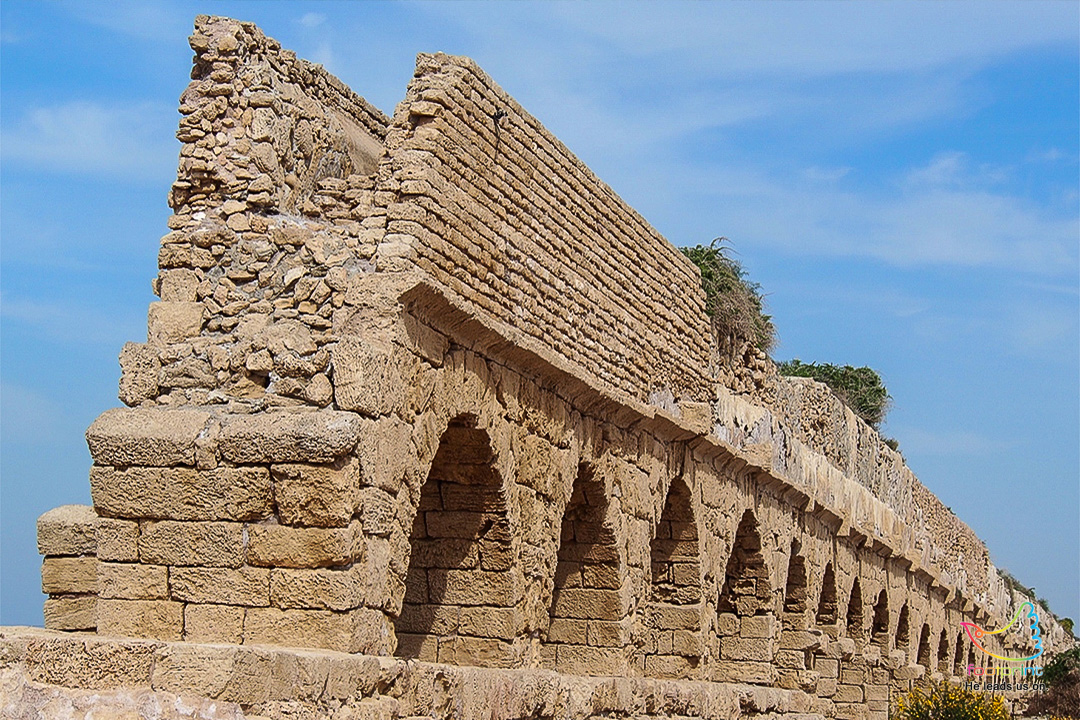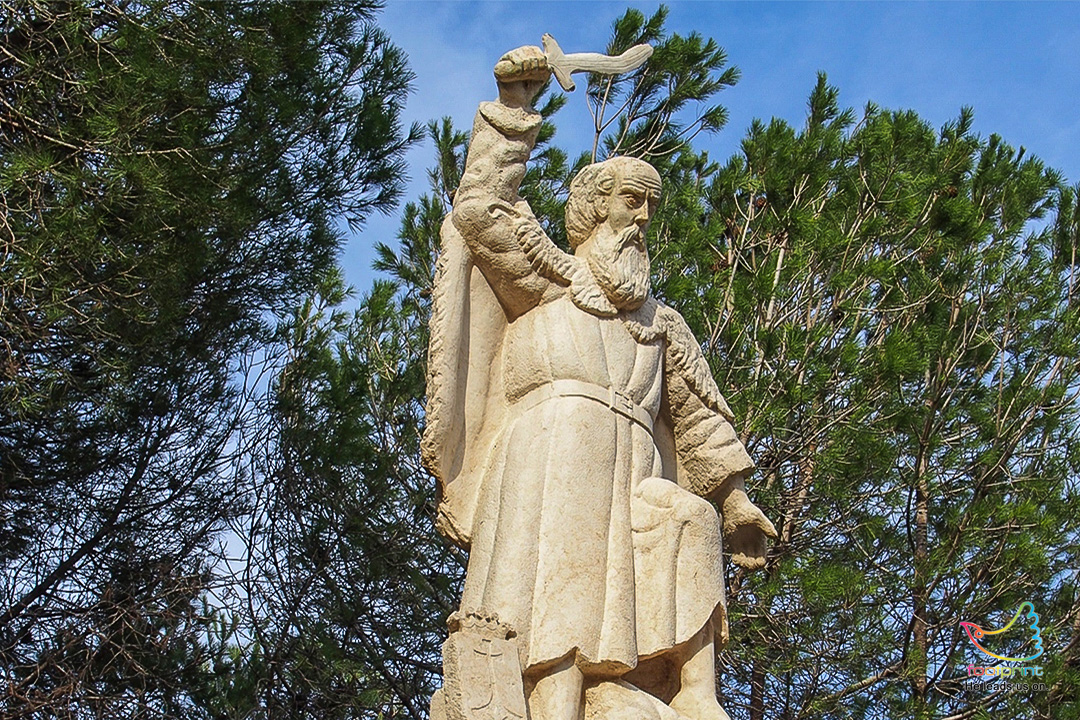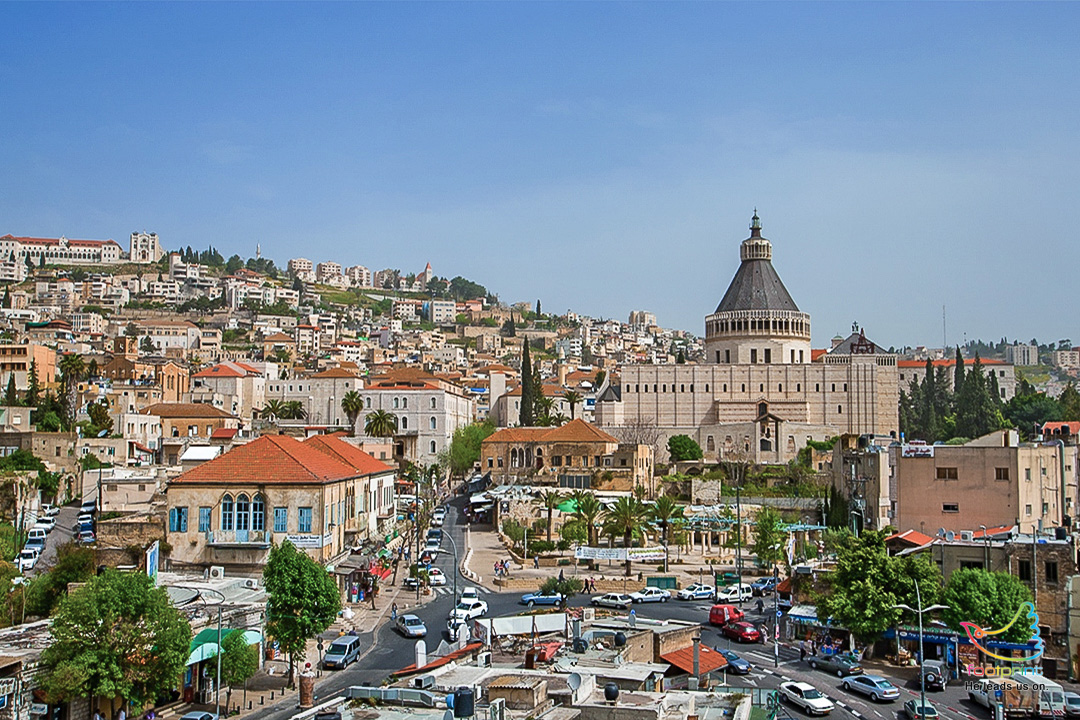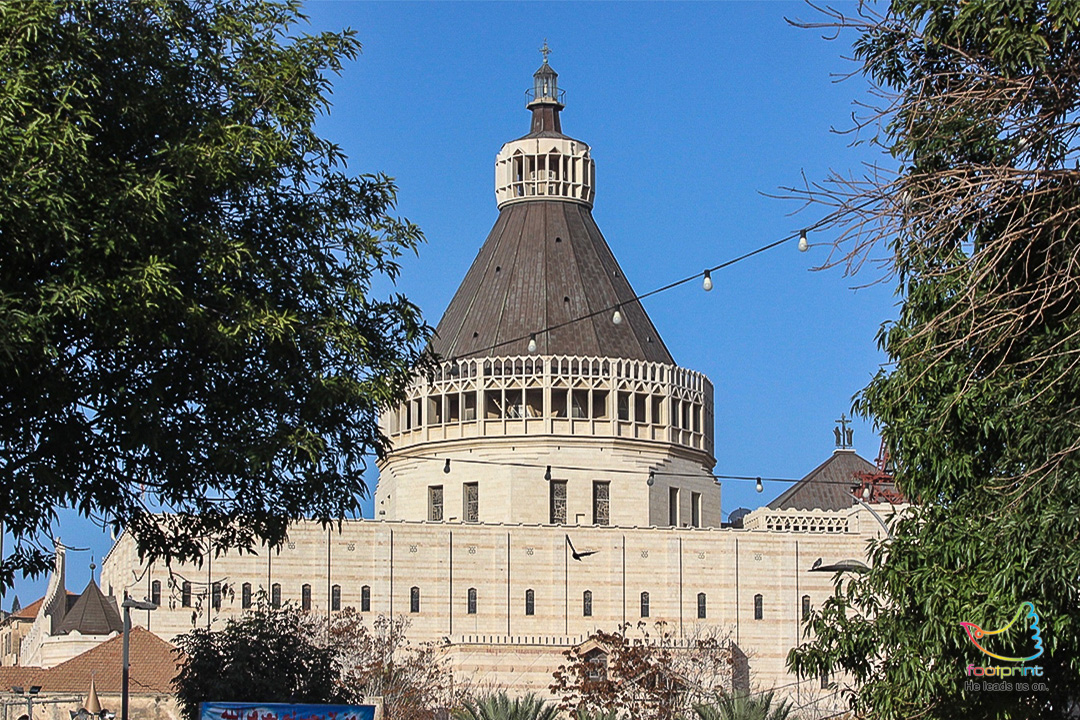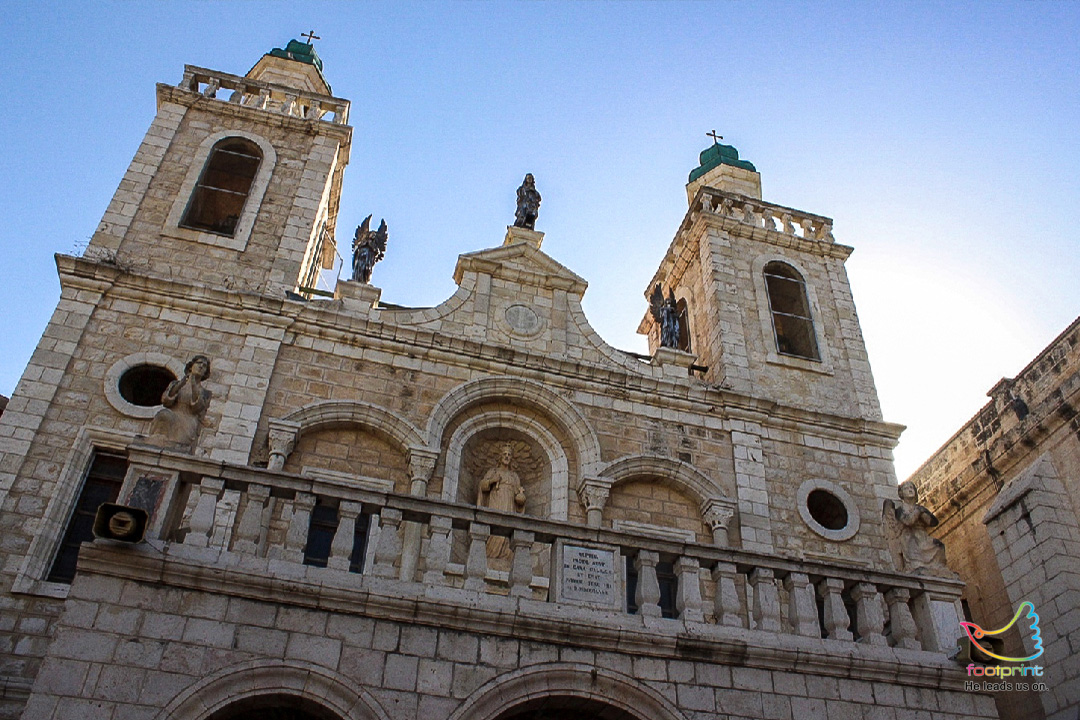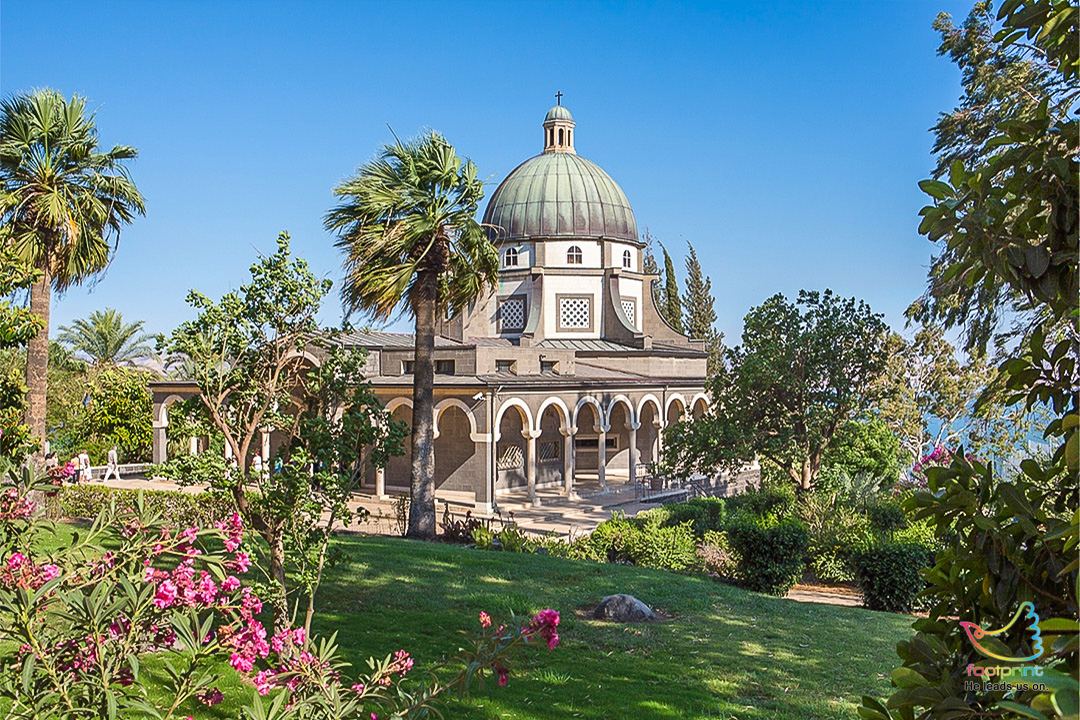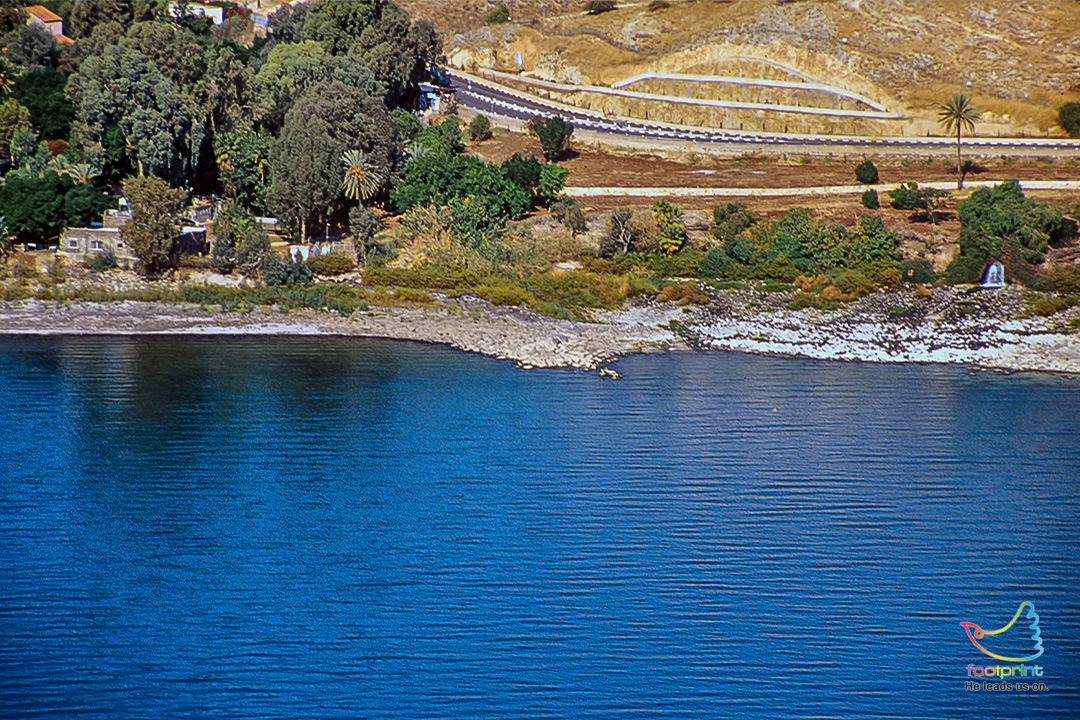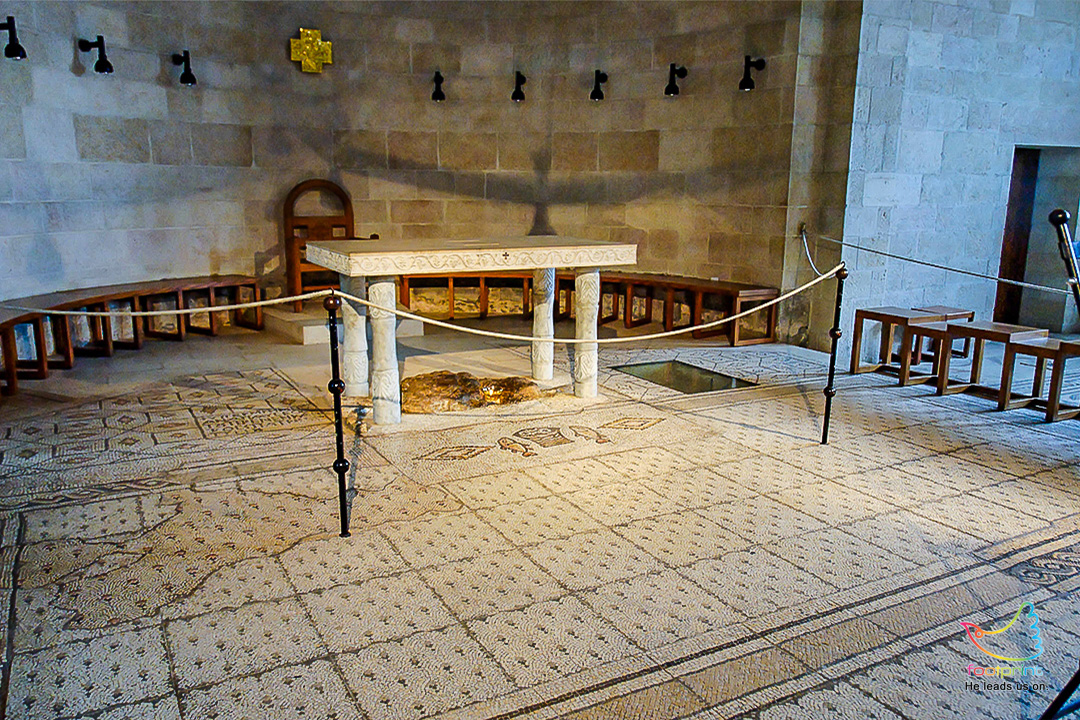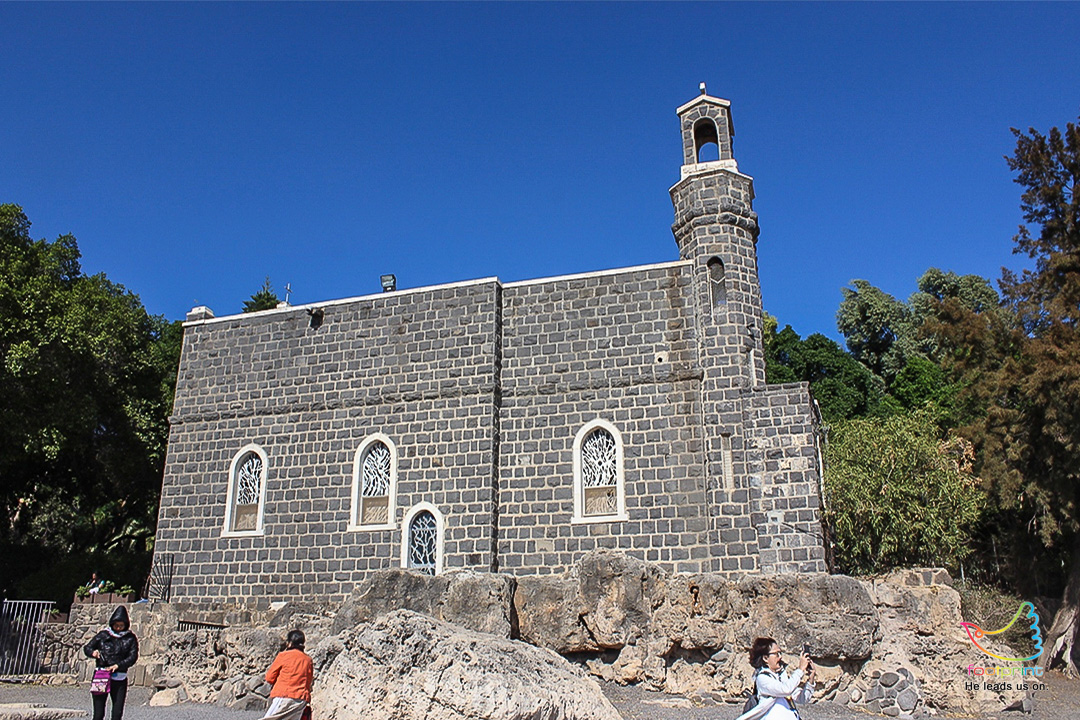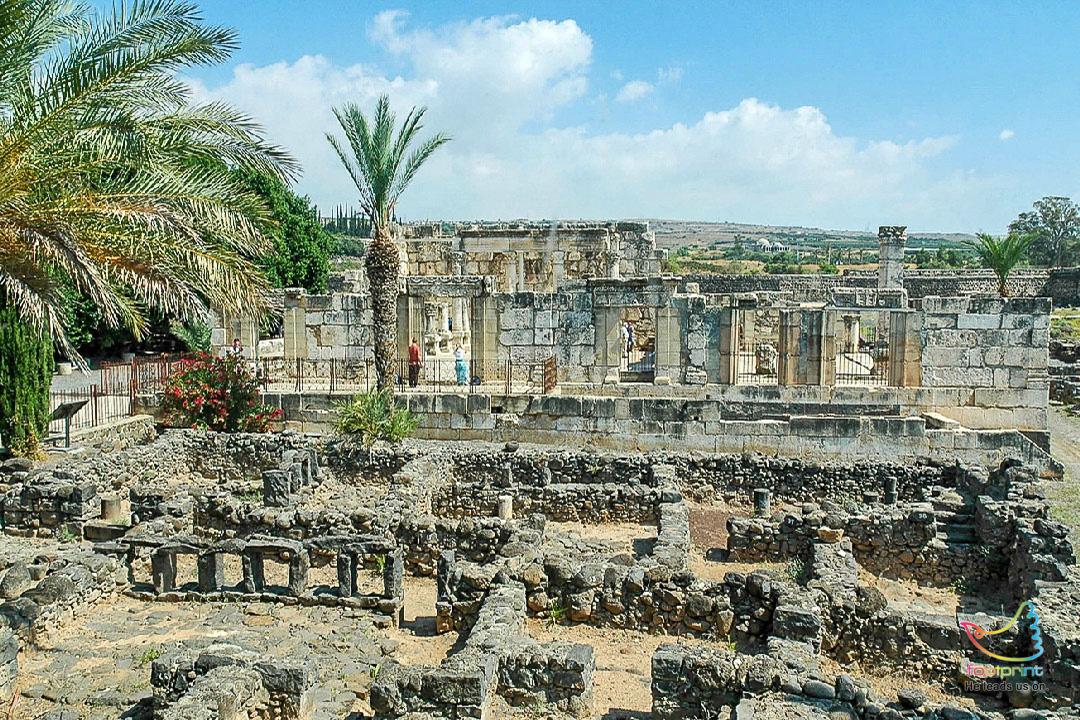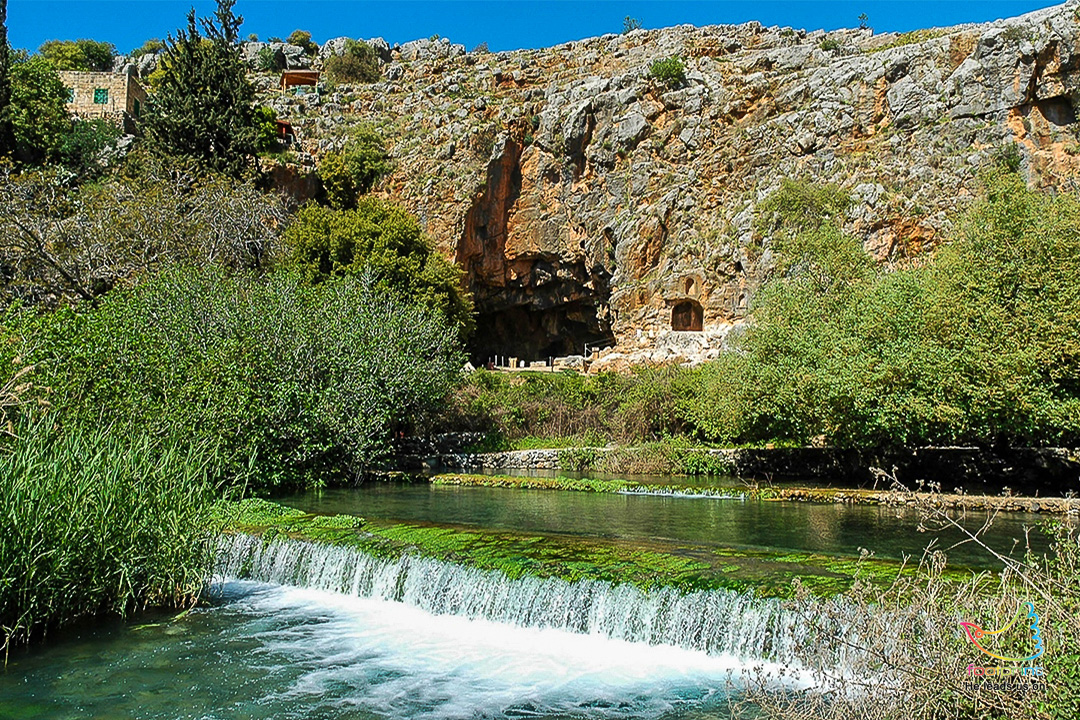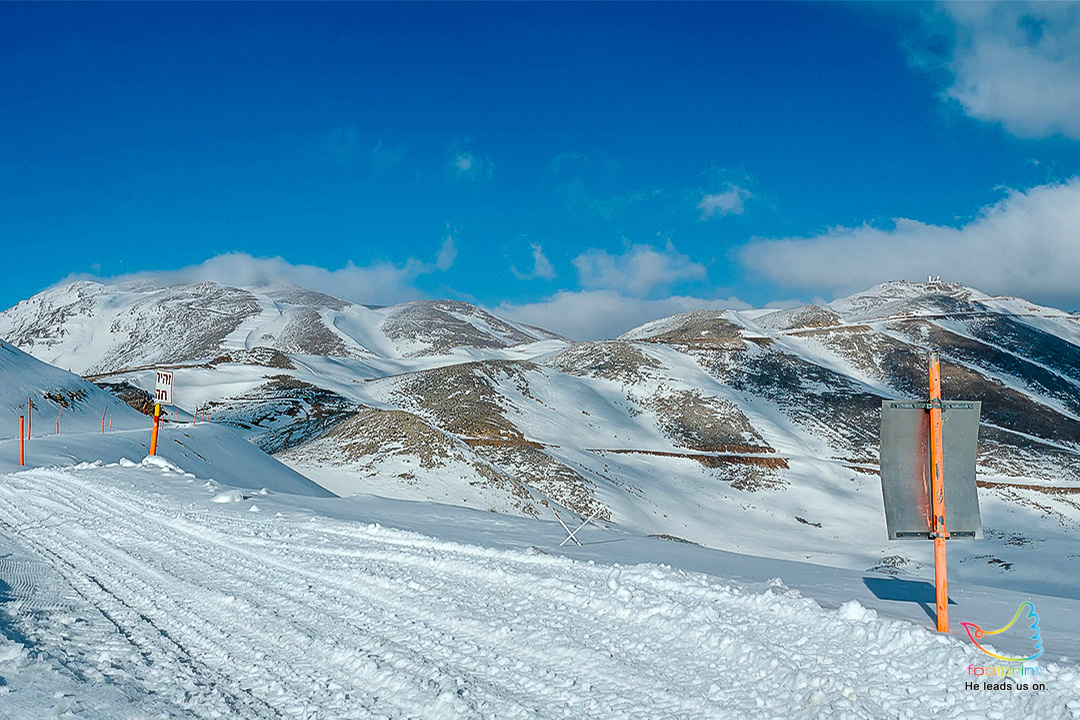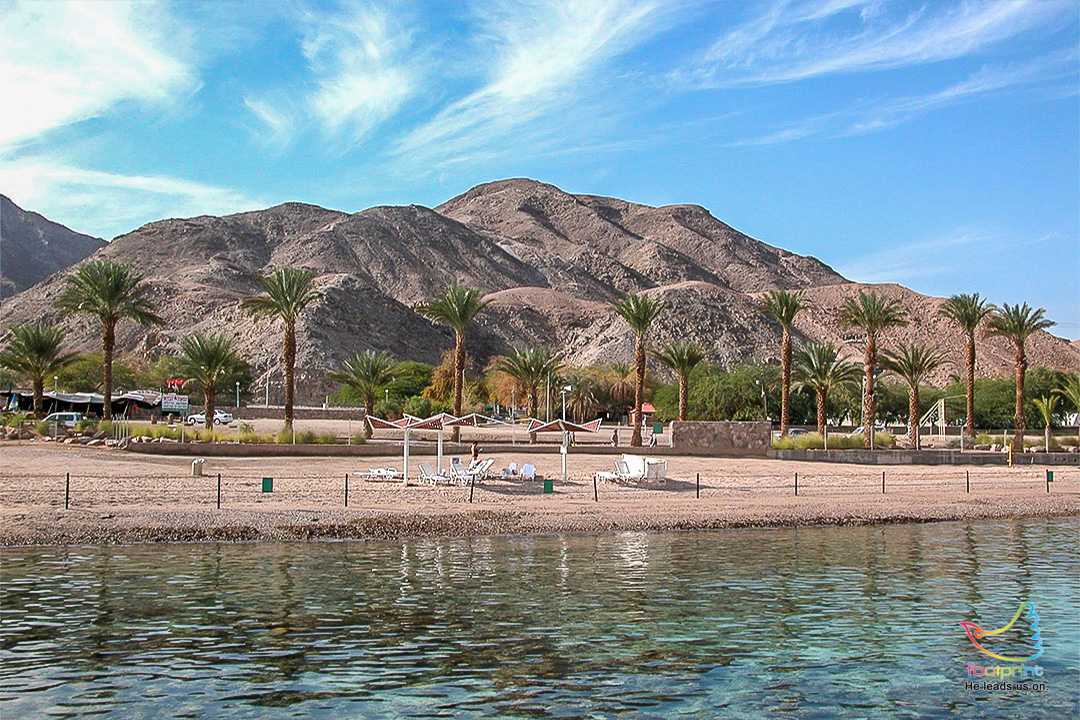JERUSALEM & NEARBY REGION
The Mount of Olives – a breathtaking view of the Holy City of Jerusalem. The Mount of Olives is the site where Jesus will step his feet on during his second – coming.
In Scripture:
King David flees over the Mount of Olives: 2 Samuel 15:30
King Solomon builds pagan temples: 1 Kings 11:7-8
“Glory of the Lord” stops on Mount of Olives: Ezekiel 11:23
Splitting of mount prophesied: Zechariah 14:3-4
Jesus enters Jerusalem: Luke 19:29-44
Jesus foretells his Second Coming: Matthew 24:27-31
Jesus prays before his arrest: Matthew 26:30-56
Jesus ascends into heaven: Acts 1:1-12
The Chapel of the Ascension (Luke 24: 50-53) – the site from which it is believed Jesus ascended to heaven 40 days after his resurrection. Inside is a rock, which many believe has the last footprint of Jesus on earth before he ascended into heaven.
In Scripture:
Jesus ascends to heaven: Acts 1:9-11
The Church of the Pater Noster – The earliest church on this site was actually called Church of Eleona (Greek for olive grove). The church is built above a cave considered to be the site where Jesus would teach his disciples, including the Lord’s Prayer (Luke 11: 1-4, Matthew 6: 5-15).
In Scripture:
Jesus teaches the Lord’s Prayer: Matthew 6:7-14; Luke 11:1-4
Jesus foretells his Second Coming: Matthew 24,25
The Church of Dominus Flevit – The name of the church means “The Lord Wept” and it marks the site where on Palm Sunday Jesus prophesized the destruction of Jerusalem and wept. The roof of the church gives the impression of a teardrop. Inside the altar is situated in the west of the church; this is very unusual (altars are almost always in the east) but it means that visitors can look out through the window beyond the altar over the Old City of Jerusalem, imagine Jesus’ view and see the fulfillment of his prophecy (Luke 19: 41-44).
In Scripture:
Jesus laments over Jerusalem: Luke 13:34
Jesus weeps over Jerusalem: Luke 19:37-44
The Church of All Nations – site of the Garden of Gethsemane (Matthew 26:36-56, Luke 22: 39-53) where Jesus spent his final night and pray alone before his arrest. Gethsemane, the name of this area comes from the Hebrew Gat Shemanim meaning ‘oil presses’ – this would have been an area for the manufacture of olive oil from the surrounding groves. The church actually has in its courtyard the oldest olive trees in Israel. Olive trees do not have rings and so their age cannot be precisely determined, but scholars estimate their age to anywhere between one and two thousand years old.
In Scripture:
Jesus prays in Gethsemane: Matthew 26:36-46; Mark 14:32-42; Luke 22:39-46; Mark 32-42
Jesus is arrested: Matthew 26:47-56; Mark 14:43-50; Luke 22:47-53; John 18:1-12
The West Bank city of Bethlehem, about 9km south of Jerusalem, is celebrated by Christians as the birthplace of Jesus Christ.
Here Mary gave birth in a cave used for animals. Here the local shepherds came to worship the baby, and here the Three Wise Men from the east came to pay homage and present their gifts.
Here too, 1000 years before Christ, Bethlehem was the birthplace of David, Israel’s second king. Here David was anointed as king by the prophet Samuel after being brought in from tending his father’s sheep.
The cave where the birth took place and the manger stood can now be visited underneath the huge Basilica of the Nativity. This is the oldest complete church in the Christian world.
In Scripture:
Birth of Messiah prophesied: Micah 5:2-5
The birth of Jesus: Luke 2:1-20; Matthew 1:18-25
The visit of the Wise Men: Matthew 2:1-12
Massacre of the Holy Innocents: Matthew 2:16-18
The Nativity Grotto in Bethlehem – the cave in which Jesus of Nazareth was born. The church that built on it is The Church of Nativity (Matthew 1: 18-24). It was originally built by Emperor Constantine.
In Scripture:
The birth of Jesus: Luke 2:1-20; Matthew 1:18-25
The visit of the Wise Men: Matthew 2:1-12
The Shepherds’ Field – identified as the scenes where the Angel of the Lord visited the shepherds and informed them of Jesus’ birth (Luke 2: 8-10).
In Scripture:
An angel appears to the shepherds: Luke 2:8-20
The story of Ruth: Ruth 1-4
The Temple Mount was built on Mount Moriah, where Jesus was presented in the Temple by His earthly parents Joseph and Mary and years later where He stayed behind to debate with the teachers (Luke 2 : 22-50).
The Pool at Bethesda – identified as the scene of one of Jesus’ miracles. This was the healing of the paralysed man who had waited for 38 years for someone to help him into the pool “when the water is stirred” — an event believed to have curative powers. Jesus told the man, “Stand up, take your mat and walk”, and immediately he was made well (John 5:2-18).
In Scripture:
Jesus heals a sick man: John 5:2-18
Via Dolorosa – the route that Jesus took between his condemnation by Pilate and his crucifixion and burial. The Via Dolorosa Route (Way of Sorrows) incorporating 14 Stations of the Cross, identifying with the suffering of Jesus on his way to crucifixion.
In Scripture:
The crucifixion: Matthew 27:24-61; Mark 15:15-47; Luke 23:24-56; John 18:13—19:42
The empty tomb: Matthew 28:1-10; Mark 16:1-8; Luke: 24:1-12; John 20:1-10
The last five Stations of the Cross are situated inside the Church of the Holy Sepulchre. The Church covers what Christians believe is the site of the most important event in human history.
In Scripture:
The crucifixion: Matthew 27:27-56; Mark 15:16-41; Luke 23:26-49; John 19:16-37
The burial of Jesus: Matthew 27:57-66; Mark 15:42-47; Luke 23:50-56; John 19:38-42
The Resurrection: Matthew 28:1-10; Mark 16:1-8; Luke 24:1-12; John 20:1-10
This is the Tomb of Christ, the Fourteenth Station of the Cross. This stone monument encloses the tomb (Sepulchre) where it is believed Jesus lay buried for three days and where he rose from the dead on Easter Sunday morning.
The Garden Tomb – a tranquil environment for prayer and reflection. The Garden Tomb has an aura of calmness that encourages meditation. With beautiful ambience, you can reflect on Christ’s life the resurrection and His message to Holy Communion.
In Scripture:
The burial of Jesus: Matthew 27:57-66; Mark 15:42-47; Luke 23:50-56; John 19:38-42
The Resurrection: Matthew 28:1-10; Mark 16:1-8; Luke 24:1-12; John 20:1-10
Ein Karem – Christian tradition places the birth of John the Baptist — who announced the coming of Jesus Christ, his cousin.
Luke’s Gospel tells of the circumstances of John’s birth (1:5-24, 39-66).
The angel Gabriel appeared to the elderly priest Zechariah while he was serving in the Temple and told him that his wife Elizabeth was to bear a son. Zechariah was skeptical, so he was struck dumb and remained so until the baby John was born
In Scripture:
The birth of John the Baptist: Luke 1:5-24, 39-66
Mary visits Elizabeth: Luke 1:39-45
The Magnificat: Luke 1:46-55
Holocaust History Museum – YadVashem, Israel’s official memorial to the Jewish victims of the Nazi Holocaust. The museum is documenting the story of the six million victims committed by Nazis during World War II.
The Western Wall or “Wailing Wall”, the most religious site in the world for the Jewish people. Located in the Old City of Jerusalem, it is the western support wall of the Temple Mount. Thousands of people journey to the wall every year to visit and recite prayers. These prayers are either spoken or written down and placed in the cracks of the wall
In Scripture:
Solomon builds the Temple: 1 Kings 5-6
Jesus foretells the destruction of the Temple: Mark 13:1-8
The Cenacle room on Mount Zion in Jerusalem is where two major events in the early Christian Church are commemorated: The Last Supper (the upper room) and the coming of the Holy Spirit on the apostles at Pentecost.
In Scripture:
The Last Supper: Matthew 26:17-30; Mark 14:12-25; Luke 22:7-23; John 13:1—17:26
The coming of the Holy Spirit: Acts 2:1-4
Jesus appears before Caiaphas: Matthew 26:57-68; Mark 14:53-65; Luke 22:66-71; John 18:12-14, 19:24
The first Church Council of Jerusalem: Acts 15:1-29
Tomb of King David — the celebrated Old Testament warrior king of Israel who is traditionally credited with composing many of the Psalms.
In Scripture:
King David’s last words: 2 Samuel 23:1-7
King David’s death: 1 Kings 2:10
King David’s reign: 1 Chronicles 29:26-30
Hezekiah’s Tunnel – King Hezekiah’s workmen dug this in the 7th century BC to bring water to the Pool of Siloam – one of the most ingenious engineering accomplishments of ancient times. King Hezekiah built a tunnel to channel water from the Gihon spring into Jerusalem so that the city would be assured of a constant water supply (2 King 20: 20; 2 Chronicles 32: 30).
Pool of Siloam. Jesus healed a blind man by spitting on the ground and applying the clay to the man’s eyes and telling him to wash them in the Pool of Siloam (John 9:6-11).
In Scripture:
King Hezekiah digs a tunnel: Sirach 48:17
Building the Pool of Siloam: Nehemiah 3:15
Jesus heals a blind man: John 9:1-41
Church of St. Peter in Gallicantu – one of the most striking churches in Jerusalem which commemorates the apostle Peter’s triple denial of his Master, his immediate repentance and his reconciliation with Christ after the Resurrection. Galli-cantu means cockcrow in Latin. Under the church is a dungeon thought to be the cell where Jesus was detained for the night following his arrest.
In Scripture:
Peter denies Jesus: Matthew 26:69-75
Ben Yehuda Street is a major street in downtown Jerusalem, Israel. It joins with Jaffa Road and King George Street to form the Downtown Triangle central business district. It is now a pedestrian mall and closed to vehicular traffic. The street runs from the intersection of King George Street to Zion Square and Jaffa Road.
Jericho – the name means “City of Palms”, reputed to be the oldest town on earth and also the lowest (more than 250 meters below sea level), with stories to match. The Israelites supposedly brought down its walls with a great shout and trumpet blasts (Joshua 5:13- 6:27). Here Jesus healed Bartimaeus, the blind beggar, and dined with Zacchaeus (Mark 10:4-52), the rich tax collector (Luke 19:1-10).
In Scripture:
Joshua captures Jericho: Joshua 6:1-21
Elisha purifies the spring: 2 Kings:19-22
Zacchaeus meets Jesus: Luke 19:1-10
Jesus heals Bartimaeus: Mark 10:46-52
The Good Samaritan: Luke 10:25-37
The Mount of Temptation, with a gravity-defying monastery clinging to its sheer face, is traditionally regarded as the mountain on which Christ was tempted by the devil during his 40-day fast. (Matthew 4:1-4)
The summit of the mount, about 360 metres above sea level, offers a spectacular panoramic view of the Jordan Valley, the Dead Sea and the mountains of Moab and Gilead.
In Scripture:
Jesus is tempted by the devil: Matthew 4:1-11, Luke 4:1-13
DEAD SEA & NEARBY REGION
The rocktop fortress of Masada has a quasi-religious significance as a symbol of resistance for the people of Israel. The story of 960 defenders choosing self-inflicted death rather than surrender has achieved legendary status for the Jewish people.
Qumran is famous as the hiding place of the Dead Sea Scrolls, a literary treasure trove hidden since shortly after the time of Christ.The site is north-west of the Dead Sea, about 15km south of Jericho and about 1.5km west of the road that runs along the western shore of the Dead Sea.
The Dead Sea – is the lowest point on earth, to enjoy swimming and relaxation. The Dead Sea, which shimmers like a blue mirror under all-day sunshine, is one of the most unusual bodies of water in the world. Set in the lowest dry land on earth, it has no outlet. It is so loaded with minerals that no fish can live in it. It is so dense that bathers can lie back on its surface and read a newspaper.
Because it has no exit, water is lost only through evaporation, which leaves behind the minerals. The Dead Sea is nearly 10 times as salty as the open seas. The high concentration of minerals (predominantly magnesium chloride) provides the buoyancy that keeps bathers suspended — as well as a bitter taste.
In Scripture:
God destroys Sodom and Gomorrah: Genesis 19:24-26
Prophesy that the Dead Sea will become fresh: Ezekiel 47:8-10
COASTAL MEDITERRANEAN SEA REGION
Tel-Aviv -Jaffa, Jaffa was formally merged with Tel Aviv in 1950.
Jaffa, one of the oldest port cities on earth, is famous for its association with the biblical stories of Jonah, Solomon and St Peter.This is wherePeter accepted an invitation to visit a centurion called Cornelius at Caesarea, about 48 kilometres up the coast, and accepted Cornelius as the first gentile to convert to Christianity (Acts 10).
In Scripture:
Timber from Lebanon to be sent to Joppa: 2 Chronicles 2:16; Ezra 3:7
Jonah sails from Joppa: Jonah 1:3
Peter raises Tabitha from the dead: Acts 9:36-43
Peter’s vision in Joppa: Acts 10:5-16
Caesarea Maritima (”by the sea”), once the capital of Roman Province, where the apostle Peter baptised the first recorded gentile convert to Christianity — Cornelius.
In Scripture:
Philip arrives in Caesarea: Acts 8:40
Agabus prophesies Paul’s death: Acts 21:8-11
Peter visits Cornelius: Acts 10
God strikes down Herod Agrippa I: Acts 12:21-23
Paul is imprisoned in Caesarea: Acts 23:23—26:32
Haifa is the third-largest city in Israel – after Jerusalem and Tel Aviv. It is home to the Bahá’í World Centre, a UNESCO World Heritage Site and a destination for Bahá’í pilgrims.
Built on the slopes of Mount Carmel, the settlement has a history spanning more than 3,000 years.
The Summit of Mount Carmel is called in Arabic el-Muhraqa – a sacred place often cited in the Old Testament for its beauty and fertility.
It is here that Elijah triumphs over the priests of Baal (1 Kings 18:1-40). Elijah called on Ahab to assemble the 450 priests of Baal on Mount Carmel where he challenged the priests to call on fire from Baal to light a sacrifice.
As the book of 1 Kings relates, Baal failed to respond to the priests’ cries. Then Elijah rebuilt the ruined altar of the Lord and offered a sacrifice. Immediately fire from heaven consumed the offering, even though it had been soaked in water.
In Scripture:
Elijah triumphs over the priests of Baal: 1 Kings 18:1-40
Elijah prays on Mount Carmel: 1 Kings 18:41-46
NORTHERN SEA OF GALILEE & NEARBY REGION
Nazareth in Galilee is commemorated by Christians as the town where the Virgin Mary, aged around 14 years, agreed to become pregnant with the Son of God. Being hidden from the public eye, nestled in a hollow among the hills of Galilee, Nazareth provided an ideal setting for the years of preparation Jesus needed as he “increased in wisdom and in years, and in divine and human favor” (Luke 2:52).
In Scripture:
The Annunciation: Luke 1:26-38
The Holy Family settles in Nazareth: Matthew 2:23; Luke 2:39-40
Jesus preaches in the synagogue: Luke 4:16-30; Matthew 13:53-58; Mark 6:1-6;
“Can anything good come out of Nazareth?”: John 1:45-46
The towering cupola of the Church of the Annunciation in Nazareth stands over the cave that tradition holds to be the home of the Virgin Mary. Here, it is believed, the archangel Gabriel told the young Mary that she would become the mother of the Son of God. And here Mary uttered her consent: “Let it be done to me according to your word.” (Luke 1:26-38)
In Scripture:
The Annunciation: Luke 1:26-38
Cana in Galilee is the scene of Jesus’ first miracle. It is actually the place of his first two public miracles in Galilee — the changing of water into wine (John 2: 1-11) and the remote healing of an official’s son 32km away in Capernaum (John 4:46-54).
In Scripture:
The miracle at the wedding feast: John 2:1-11
Jesus heals the official’s son: John 4:46-54
Tiberias is an Israeli city on the western shore of the Sea of Galilee. it was named in honour of the second emperor of the Roman Empire, Tiberius.Tiberias is a popular base for Christian pilgrims exploring the Galilee that Jesus knew.
A classic boat ride across the Sea of Galilee. Here, Jesus rebuked the winds and the sea (Matthew 8:23–27), taught from Peter’s boat (Luke 5:3), and walked on water (Mark 6:45-52). You will take a memorable boat ride in a traditional fishing boat.
In Scripture:
Jesus calls his disciples: Matthew 4:18-22; 9:9; Mark 1:16-20
The miraculous catch of fish: Luke 5:1-11
Jesus calms the storm: Mark 4:35-41; Matthew 8:23-27; Luke 8:22-25
Jesus walks on the water: Matthew 14:22-33; Mark 6:45-52
The Sermon on the Mount: Matthew 5:1-7:28
The Parable of the Sower: Mark 4:1-9
The feedings of the crowds: Matthew 14:13-21; 15:32-39; Mark 6:30-44; 8:1-9; Luke 9:10-17; John 6:1-14
Paying the Temple tax: Matthew 17:24-27
Mount of Beatitudes – where Jesus delivered the famous Sermon on the Mount (Matthew 5–7; Luke 6), looking out over the Golan Heights and the Sea of Galilee. The Mount of Beatitudes, believed to be the setting for Jesus’ most famous discourse, the Sermon on the Mount, is one of the most beautifully serene places in the Holy Land.
In Scripture:
The Sermon on the Mount: Matthew 5:1-7:28
The parable of the sower: Mark 4:1-9
Jesus commissions the disciples: Matthew 28:16-20
Tabgha is at the foot of the Mount of Beatitudes – best known for Christ’s miraculous multiplication of loaves and fish to feed a multitude — 5000 men, plus women and children — where he took five loaves and two fish, “looked up to heaven, and blessed and broke the loaves . . . and the disciples gave them to the crowds”. After they had eaten, the leftovers filled 12 baskets (Mark 6: 35–44).
The modern Church of the Multiplication of the Loaves and Fishes at Tabgha stands on the site of a 4th-century church, displaying Byzantine mosaic decorations that are among the most elegantly executed in the Holy Land.
In Scripture
Miraculous feeding of 5000: Matthew 14: 13-21; Mark 6:30-44; Luke 9:10-17; John 6:1-14
The Church of the Primacy of Peter is where Jesus’ reinstatement of Peterafter a fish breakfasts on the shore: “feed my lambs… tend my sheep… feed my sheep.” (John 21: 15-19).
In Scripture
Jesus commissions Peter: John 21: 1-19
Capernaum was the Centre of Jesus’ Galilean ministry (Matthew 4:13) after He left Nazareth. We see the remaining of an early Church, the ruins of Peter’s House, and walk inside of the ancient stone synagogue where Jesus preached — where his teaching made a deep impression on the local people because, unlike the scribes, he taught with authority. (Mark 1:21-22). In the same synagogue, Jesus promised the Eucharist in his “I am the bread of life” discourse (John 6:22-59). Jesus lived here for a substantial period, healing the sick, preaching in the synagogue and performing miracles like delivering a man of unclean spirits (Mark 1:23–26). Another miracle that was performed here was the healing of the paralytic lowered through the roof (Mark 2:1–12).
In Scripture:
Jesus makes his home in Capernaum: Matthew 4:12-17
Jesus teaches in the synagogue: Mark 1:21-28
Jesus cures Peter’s mother-in-law: Mark 1:29-31
Paying the temple tax: Matthew 17:24-27
Jesus calls Matthew: Matthew 9:9-12
Jesus condemns Capernaum: Matthew 11:20-24
Jesus heals a centurion’s servant: Luke 7:1-10
Jesus cures a paralysed man: Mark 2:1-12
“I am the bread of life”: John 6:22-59
Yardenit, Jordan River – is the site to commemorate Christ’s baptism. It is significant for Christians because John the Baptist baptised Jesus in the waters of the Jordan River. You may renew your baptismal promises here (self-account), often in white robes and undergoing total immersion in the mild waters of the Jordan.
In Scripture:
The Israelites cross the Jordan on dry ground: Joshua 3:14-17
Elijah crosses the Jordan on dry ground: 2 Kings 2:8
John baptises Jesus: Matthew 3:13-17; Mark 1:9-11; Luke 3:21-22; John 1:29-34
Naaman’s leprosy is cured in the Jordan: 2 Kings 5:1-14
Diamond Factory -The Israeli Diamond Industry is one of the most important and largest diamond centers worldwide. It is also a leading diamond polishing center. It prides itself on its skillfulness and uniqueness as well as its unprecedented creativity and cutting-edge technology.
Near Caesarea Philippi(Banias in Arabic), a city of Greek-Roman culture known for its worship of foreign gods, Jesus announced he would establish a church and gave authority over it to the apostle Simon — whom he renamed Peter.
When Christ asked, “Who do people say that the Son of Man is?” it was Simon Peter who was inspired to answer: “You are the Messiah, the Son of the living God.”
In reply, Christ declared: “And I tell you, you are Peter, and on this rock I will build my church, and the gates of Hades will not prevail against it. I will give you the keys of the kingdom of heaven, and whatever you bind on earth will be bound in heaven, and whatever you loose on earth will be loosed in heaven.” (Matthew 16: 13–20; Mark 8: 27–30)
In Scripture:
Peter calls Jesus the Messiah: Matthew 16:13-20
Jesus foretells his death: Mark 8:31—9:1
Mount Hermon is the southern tip of the anti-Lebanon mountain range. Its highest peak is 9,230 feet and the highest point inside Israel’s borders today is MizpeShelagim at 7,295 feet. The mountain is the only place with snow skiing in the country.More than twenty ancient temples have been found on the mountain or in its vicinity.
In Scripture:
It is as if the dew of Hermon were falling on Mount Zion: Psalm 133:3
Come with me from Lebanon, my bride…. Descend from the crest of Amana, from the top of Senir, the summit of Hermon, from the lions’ dens and the mountain haunts of the leopards.: Song 4:8
SOUTHERN REGION
Eilat is Israel’s southernmost city, a busy port and popular resort at the northern tip of the Red Sea, on the Gulf of Aqaba. The city’s beaches, coral reef, nightlife and desert landscapes make it a popular destination for domestic and international tourism.
CONTACT US

FOOTPRINT TRAVEL PLANNER SDN BHD
(Co. No. 801262-U) (KPL No. 5370)
Wisma New Asia,
Level 1, Unit 119,
Jalan Raja Chulan,
50200 Kuala Lumpur, Malaysia
Tel: +6014-654 1909

